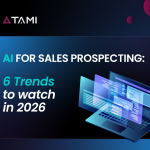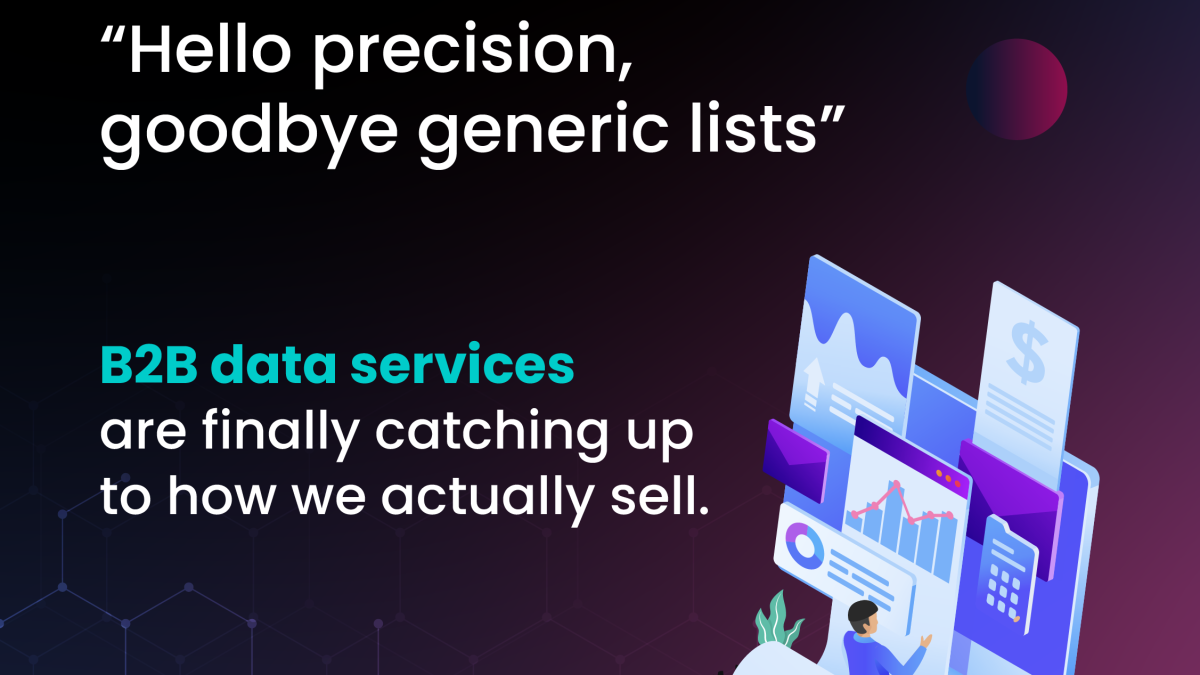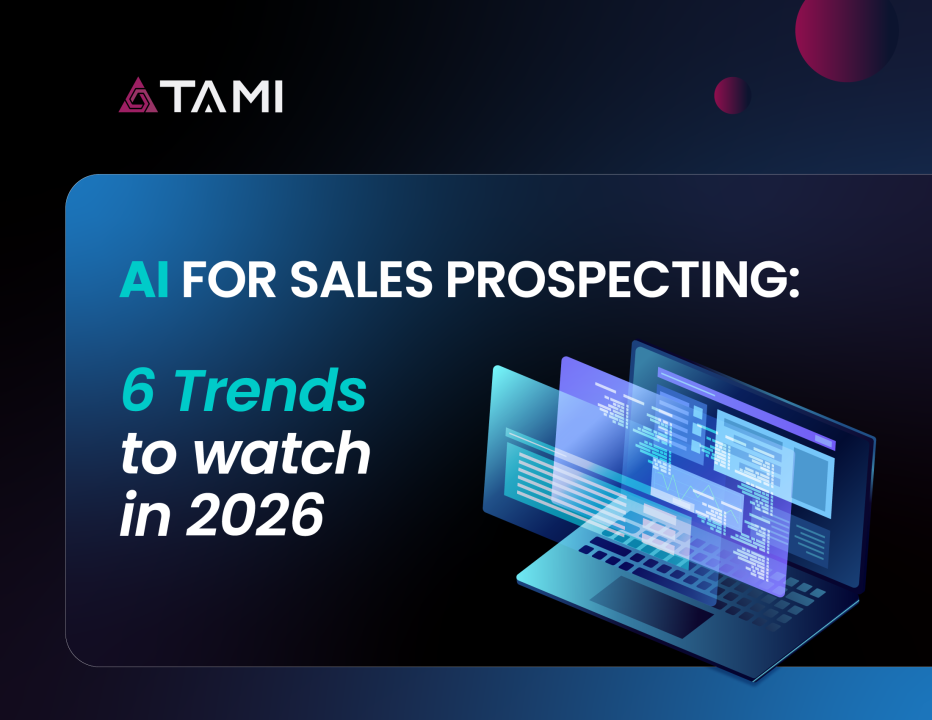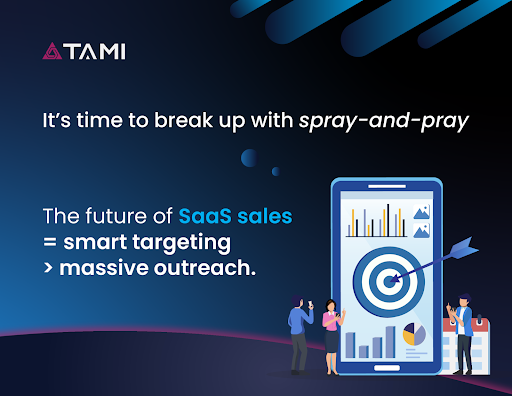
New Feature: Send WhatsApp Messages Directly from TAMI
05/11/2025
AI for Sales Prospecting: 6 Trends to Watch in 2026
06/11/2025In the next era of B2B data services, success will depend on delivering contact data that is current, customized, and contextually relevant. Generic lists built once and used forever will lose their edge. Tomorrow’s winners will layer real-time enrichment, role-specific filters, and signal-based targeting to surface exactly the right buyers at the right moment.
This evolution is already underway. Tools that only append job titles or firmographics are being overtaken by platforms that monitor changes like promotions, tech stack shifts, competitor activity. The future is about data that adapts, not data that ages.
In this article we’ll map out why B2B data services must become real-time and role-focused, what shifts you should build for now, and how to put this into practice with tools like TAMI.
Why real-time and role-specific data is the next frontier
Historically, B2B contact data services offered bulk lists refreshed quarterly or semi-annually. That model survived when buyer journeys were slower and change was less frequent.
Today, that is no longer acceptable. Contacts change roles, tools, and companies at a faster rate. Without real-time updates, your outreach becomes futile: bounced emails, irrelevant titles, and stale lists.
Role-specific data adds another layer of precision. Sales isn’t interested in every contact; it cares about the decision-makers, influencers, and operators relevant to your offer. Marketing may want a broader view, while product or partnerships might need entirely different slices of data. One size fits all is obsolete.
Moreover, modern buyers expect personalization and relevance. If your outreach references that someone is running a competing tool, or mentions a recent change in their tech stack, you win curiosity and credibility. You cannot do that with generic contact info.
Finally, the ROI of data now demands that every record survive and contribute. When each contact costs money, cleaning up or replacing bad records costs more in wasted outreach and reputation damage than in tool licensing.
So B2B data services must shift. They must provide continuous enrichment, role-level filtering, and signal-driven updates. The platforms that can do this will dominate.
What’s changing: three trends to ride now
One: continuous enrichment via APIs. Instead of periodic data dumps, systems will sync updates instantly: job changes, company events, technographic changes. That means your CRM, outreach tool, or data warehouse always has the freshest record.
Two: role-specific lenses. Rather than giving you every contact in a company, data layers will let you filter by roles: decision-makers, budget holders, operations, technology management. That way your GTM teams don’t waste time on irrelevant profiles.
Three: signal overlays and triggers. Data services will layer intent, competitor change, tech adoption, funding events, hiring spikes, so your targeting is proactive. Because when a prospect changes their stack or grows their team, that’s a moment to strike.
We already see these shifts in newer platforms. Real-time enrichment tools enable lookups and appends via API. Some vendors give role-level filters and insights. And services like intent data providers layer signals over base contact data. The future data stack is becoming reactive and dynamic.
How to adopt role-specific real-time data in your stack
Begin by auditing your current CRM and data flow. Ask: how often do contacts change? How many bounce? Where are the gaps in job role coverage? From there, map out what fields you need beyond name and email: current title, functional role, tech used, competitor usage, triggers.
Choose a data service that supports API enrichment and syncs back into your systems. Avoid tools that force manual exports or stale snapshots. The more automated, the better.
Set up role-based segmentation rules in your automation or outreach tools. Tie notifications or workflows to role changes and signal events so your reps act instantly when a high-value contact gets promoted or a company adopts a new system.
Measure data health continuously. Track bounce rates, contact decay, missing titles. Monitor the yield from different role segments. Use feedback loops to refine which roles feed pipeline best for each team (sales, marketing, partnerships).
Finally, test aggressively. Pick a subset of accounts and run two streams: one driven by generic data and one driven by real-time role-specific data. Compare engagement, replies, and conversions. Iterate quickly.

Why TAMI’s architecture is tuned for this future
TAMI was built with this next generation of data services in mind. Because it continuously scans and refreshes contact and company data, it delivers up-to-date enrichment so your outreach never talks to expired or irrelevant contacts.
TAMI also layers role-level intelligence, allowing you to segment contacts not just by title but by function, decision influence, and technology context. If your business sells to product leads, operations, or tech leadership, you can filter precisely.
Signal tracking is native: technology changes, competitor adoption, shifting payment or shipping partners all feed into TAMI’s enrichment. That enables your targeting to trigger on events, not stale assumptions.
And TAMI’s architecture integrates deeply into CRMs and outreach systems. Your contacts update in place, workflows remain consistent, and your team doesn’t waste cycles importing or cleaning.
In short, the future of B2B data services is present in TAMI’s design. The tools built to thrive in that future are already available.
Risks and challenges to watch
Relying on one signal or role lens can blindside you. For example, a decision-maker might hide behind a generic title, so always layer multiple dimensions of signals.
Scaling costs can balloon if pricing is credit-based and every enrichment or update costs. Prefer models that support high volume updates without surprise fees.
Privacy and compliance remain non-negotiable. Real-time data must respect laws like GDPR, CCPA, and local rules. If a data service can’t guarantee permission-based records, you risk penalties.
Adoption friction is real. Teams often resist new systems. To mitigate, embed data enrichment deeper than optional tools. Integrate inside CRMs and automate the updating so the benefit is invisible.
Finally, real-time role-specific data is no silver bullet. Your outreach and process still need to be sharp. The data simply enables you to aim smarter. Execution still wins.
Final thoughts
In the B2B space, generic lists will become relics. The winners will be platforms that maintain live data, customize for role use cases, and integrate signal-driven intelligence.
In practice, expect data service providers to evolve: more API-first models, richer role taxonomy, more signal overlays, adaptive filtering based on pipeline feedback, and smarter automation that pushes to your tools in real time.
As users, your task is to demand this level of precision. Ask vendors not just about count or coverage, but about how often they refresh, how they classify roles, what signals they layer, and how seamless their integration is.
If your team builds on yesterday’s data models, you’ll be outpaced in 2026. Book a demo today and discover how TAMI can help you turn accurate data into measurable revenue.









